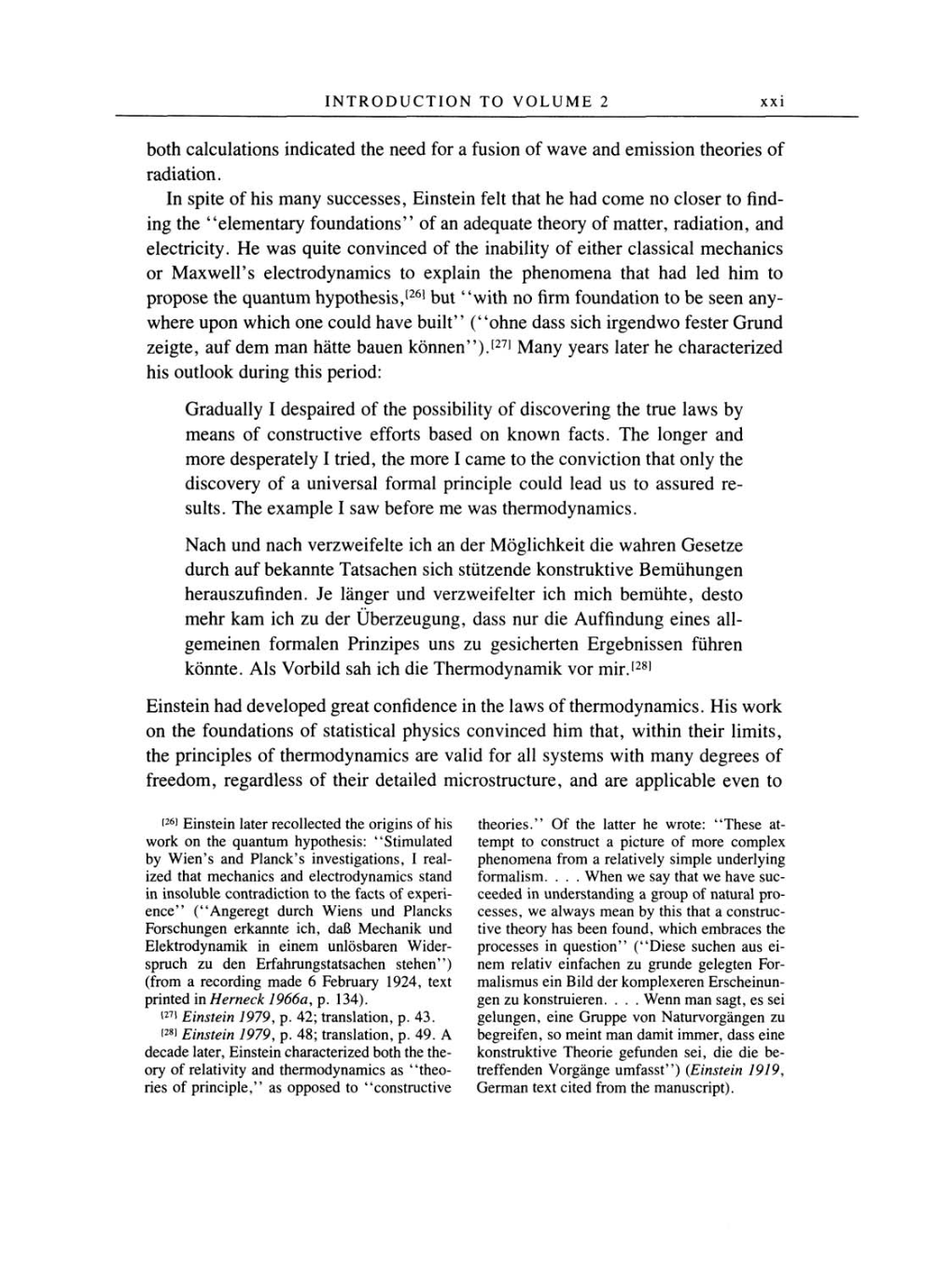INTRODUCTION
TO VOLUME
2
xxi
both calculations indicated the need for
a
fusion
of
wave
and
emission
theories
of
radiation.
In
spite
of
his
many
successes,
Einstein felt that he had
come
no
closer
to find-
ing
the
"elementary
foundations" of
an adequate theory
of
matter, radiation,
and
electricity.
He
was quite
convinced
of
the
inability
of
either classical mechanics
or
Maxwell's
electrodynamics
to
explain
the
phenomena
that had led him to
propose
the
quantum
hypothesis,[26]
but
"with
no
firm foundation to be
seen any-
where
upon
which
one
could have
built"
("ohne dass sich
irgendwo
fester
Grund
zeigte,
auf
dem
man
hätte bauen
können").[27]
Many years
later he characterized
his outlook
during
this
period:
Gradually
I
despaired
of
the
possibility
of
discovering
the true laws
by
means
of
constructive efforts
based
on
known facts. The
longer
and
more desperately
I
tried,
the
more
I
came
to
the
conviction that
only
the
discovery
of
a
universal formal
principle
could lead
us
to
assured
re-
sults. The
example
I
saw
before
me
was thermodynamics.
Nach und nach verzweifelte ich
an
der
Möglichkeit
die wahren Gesetze
durch
auf
bekannte Tatsachen sich stützende konstruktive
Bemühungen
herauszufinden. Je
länger
und verzweifelter ich mich
bemühte,
desto
mehr kam ich
zu
der
Uberzeugung,
dass
nur
die
Auffindung
eines all-
gemeinen
formalen
Prinzipes uns
zu
gesicherten Ergebnissen
führen
könnte. Als Vorbild sah ich die
Thermodynamik vor mir.[28]
Einstein
had
developed great
confidence in
the laws
of
thermodynamics.
His work
on
the foundations
of
statistical
physics
convinced
him
that,
within their limits,
the
principles
of
thermodynamics are
valid for all
systems
with
many degrees
of
freedom,
regardless
of
their
detailed
microstructure,
and
are applicable even
to
[26]
Einstein
later recollected
the
origins
of
his
work
on
the
quantum hypothesis:
"Stimulated
by
Wien's
and
Planck's
investigations, I
real-
ized that mechanics and
electrodynamics
stand
in insoluble contradiction
to
the facts
of
experi-
ence"
("Angeregt
durch Wiens und Plancks
Forschungen
erkannte
ich,
daß Mechanik und
Elektrodynamik
in einem unlösbaren Wider-
spruch zu
den
Erfahrungstatsachen
stehen")
(from
a recording
made 6
February
1924, text
printed
in
Herneck
1966a,
p.
134).
[27]
Einstein
1979,
p.
42; translation,
p.
43.
[28]
Einstein
1979,
p.
48; translation,
p.
49.
A
decade
later,
Einstein characterized both the the-
ory
of
relativity
and
thermodynamics as
"theo-
ries
of
principle,"
as opposed
to
"constructive
theories." Of
the latter he
wrote:
"These
at-
tempt
to construct
a picture
of
more complex
phenomena
from
a relatively simple
underlying
formalism.
. . .
When
we say
that
we
have
suc-
ceeded in
understanding a group
of natural
pro-
cesses,
we always mean by
this that
a
construc-
tive
theory
has been
found,
which embraces the
processes
in
question"
("Diese suchen
aus
ei-
nem
relativ einfachen
zu grunde gelegten
For-
malismus ein Bild
der
komplexeren
Erscheinun-
gen zu
konstruieren.
. . .
Wenn
man sagt, es
sei
gelungen,
eine
Gruppe von Naturvorgängen zu
begreifen,
so
meint
man
damit
immer,
dass eine
konstruktive
Theorie
gefunden
sei,
die die be-
treffenden
Vorgänge
umfasst")
(Einstein 1919,
German
text
cited from the
manuscript).
